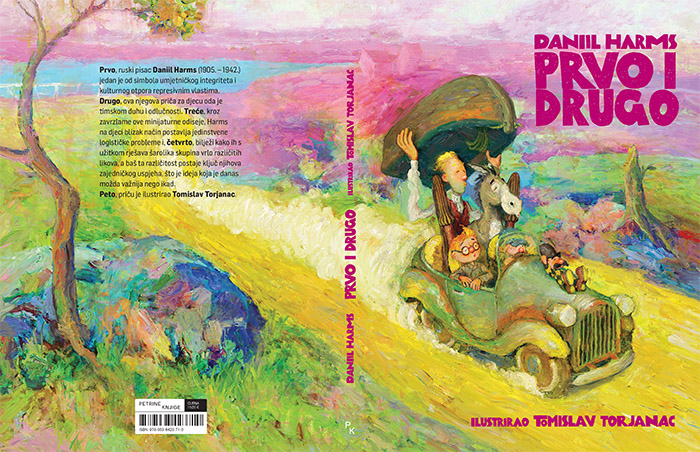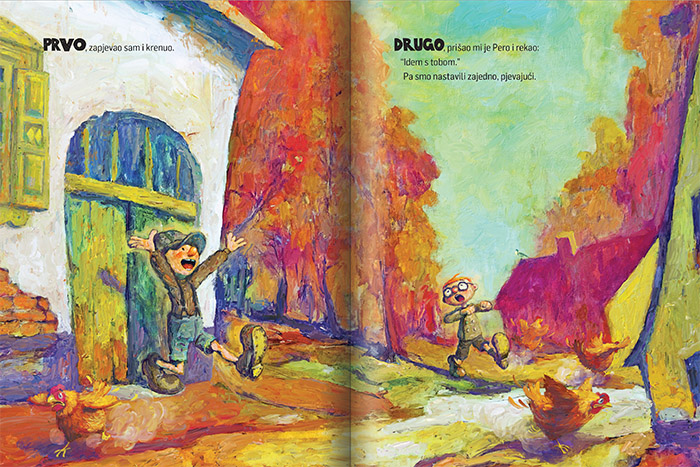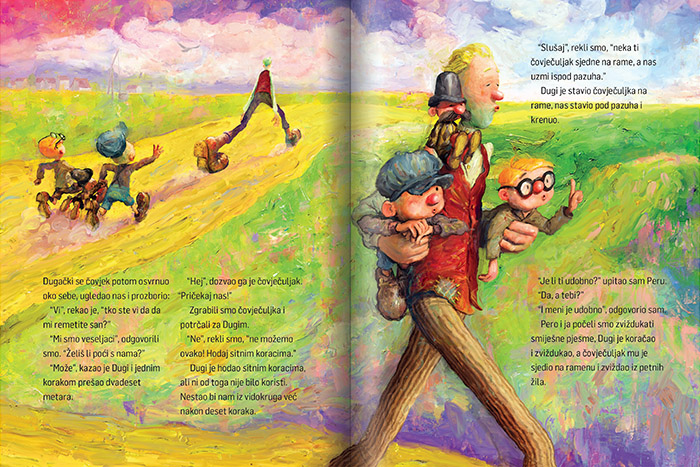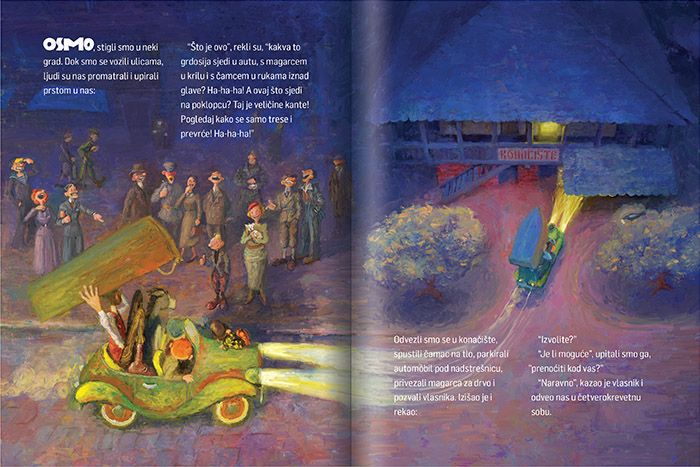


|
|
First and Second /
Prvo i drugo
Daniil Harms, Tomislav Torjanac (illustrator & translator)
Petrine knjige (HR) 2023.
| EN
In 2022 my editor suggested to me that I choose a text that I would
turn into a picture book and illustrate for Petrine knjige, the
publisher who at that time published new editions of two long-sold-out
picture books I illustrated: The Cat and Devil and The Little Girl and Giant. |
|
HR
Godine 2022. moj mi je urednik predložio neka odaberem tekst koji bih
pretočio u slikovnicu i ilustrirao za Petrine knjige, nakladnika koji je
u to vrijeme objavio nova izdanja dviju godinama rasprodanih slikovnica
s mojim ilustracijama: Mačak i vrag i Djevojčica i div.
|

| First and Second, front and back cover |
|
Prvo i drugo, naslovnica i zaslovnica |
Without too much thinking, my answer was the children’s story First and Second
by the Russian writer Daniil Kharms (1905-1942). Apart from the fact
that reading Kharms has been a “vice” for me since my early university
days, I have been saddened for just as long by the fate that befell him
during his too short life.
|
|
Bez previše razmišljanja, moj odgovor bila je priča za djecu Prvo i drugo
ruskog pisca Daniila Harmsa (1905. – 1942.). Naime, osim što mi je
čitanje Harmsa “porok” još od ranih fakultetskih dana, jednako dugo
rastužuje me okrutna sudbina koja ga je snašla za njegova prekratkog
života.
|

| First and Second, pages 2-3 |
|
Prvo i drugo, stranice 2-3 |
At the time I mentioned First and Second
to the editor, the world found itself – and still finds itself in 2023 –
in an unnatural situation that causes a natural reaction in most people
in the form of fear or at least considerable discomfort. Although I
believe that publishing Harms – regardless of whether it is his texts
for children or adults – does not require a special reason, I
interpreted all of the above as a clear sign that it should be done
right now.
|
|
U vrijeme kad sam uredniku spomenuo Prvo i drugo,
svijet se našao – i još se nalazi 2023. godine – u neprirodnoj
situaciji koja kod većine izaziva prirodni odgovor u obliku straha ili
barem poprilične nelagode. Premda držim da za objavljivanje Harmsa – bez
obzira na to je li riječ o njegovim tekstovima za djecu ili odrasle –
nije potreban poseban razlog, sve navedeno protumačio sam kao jasan znak
da bi to trebalo učiniti upravo sad.
|

| First and Second, pages 6-7 |
|
Prvo i drugo, stranice 6-7 |
The story of First and Second
is a zany Kharmsian puzzle whose clear message is that common success
always rests on mutual differences, not on uniformity. I tried to convey
that in my illustrations, giving all the characters life and tangible
character and introducing humorous elements that build on Kharms’. All
the illustrations were created using the combined technique of oil
painting on wood panels and digital media.
|
|
Priča Prvo i drugo
šašava je harmsovska zavrzlama čija je jasna poruka da zajednički
uspjeh uvijek počiva na međusobnoj različitosti, a ne na šablonskoj
sličnosti. Trudio sam se prenijeti to u svoje ilustracije, dajući svim
likovima životnost i opipljiv karakter te uvodeći humoristične elemente
koji se nadovezuju na Harmsove. Sve ilustracije nastale su kombiniranom
tehnikom slikanja uljem na drvu i digitalnog medija.
|

| First and Second, pages 16-17 |
|
Prvo i drugo, stranice 16-17 |
The picture books I illustrate I also design, but for First and Second
I also did the Croatian translation of Kharms’ original Russian text. I
have no formal education when it comes to Russian (admittedly, I don’t
have it when it comes to illustrating either). I more or less understand
Russian thanks to my mother, who – although she was of Czech origin –
studied Russian at school and somewhat reluctantly passed on the basics
of both “not-so-popular” languages to her curious son.
|
|
Slikovnice koje ilustriram u pravilu i grafički oblikujem te pripremam za tisak, ali za Prvo i drugo
potpisujem i prijevod Harmsova izvornog ruskog teksta. Nemam službenu
naobrazbu kad je riječ o ruskom (doduše, nemam je niti kad je riječ o
ilustriranju). Ruski više-manje razumijem zahvaljujući majci, koja je –
premda je bila češkog prodrijetla – u školi učila ruski i na
znatiželjnog sina pomalo nerado prenijela osnove oba “ne-baš-popularna”
jezika.
|

|
|
|
|
|
|